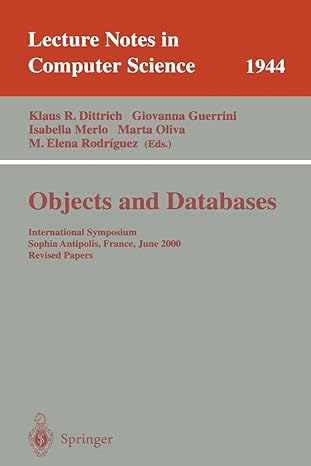Answered step by step
Verified Expert Solution
Question
1 Approved Answer
IN JAVA For testing and debugging purposes, the static methods in steps H to K below can be public instead of private. H A private
IN JAVA For testing and debugging purposes, the static methods in steps H to K below can be public instead of private.
H A private static encodeField method which takes an object parameter and encodes it as a field string
If the given object is a null reference, return a string containing the literal word null.
If it is a string, return it between literal quotation marks thus characters longer.
If it is a boolean, integer, or floating point number double return it converted to a string.
Otherwise, throw an illegal argument exception and pass it the message that the given object is unsupported.
This step H is the functional inverse of step I below.
I A private static decodeField method which takes a field parameter string and decodes it as an object.
If the given field is the literal word null or any case variant, return a null reference.
If it starts and ends with literal quotation marks return the substring between the marks, thus characters shorter.
If it is the literal word true or false or any case variant, return the corresponding boolean true or false.
If it can be parsed as an integer, return the corresponding integer.
If it can be parsed as a floating point number double return the corresponding number.
Otherwise, throw an illegal argument exception and pass it the message that the given field is unrecognized.
This step I is the functional inverse of step H above.
page
J A private static encodeRow method which takes a row parameter and encodes it as a record string
Create a string joiner with a comma as its delimiter.
Encode the key of the given row as a field using encodeField, and add it to the string joiner.
For each field in the list of fields of the given row in order, encode it using encodeField, and add it to the string joiner.
Return the string joiner converted to a string.
This step J is the functional inverse of step K below.
K A private static decodeRow method which takes a record parameter string and decodes it as a row.
Split the record on commas into a sequence of fields.
Strip the first field of whitespace and decode it as a key using decodeField.
Create a new list of fields. For each remaining field in the sequence, strip it decode it using decodeField, and add it to
the list of fields.
Return a new row composed of the key and list of fields.
This step K is the functional inverse of step J above.
L Public methods for the following properties:
The hashCode method fingerprint which returns the sum of the hash codes of the rows decoded from the records in
the flat file, excluding the header.
A public put method which takes a key parameter string then a list of fields parameter list of objects
Read all records lines from the flat file into a list of records.
If the degree of the given row doesnt match the size of the header in the list of records split using commas throw an
illegal argument exception. Dont call the degree method.
Create a new record by encoding a new row composed of the key parameter and the list of fields parameter.
Linear search the rows decoded from the list of records to find an old row with the given key, skipping the header.
On a hit, remove the old record from its index within the list of records, prepend the new record to the list of records but
still after the header, write the modified list of records to the flat file, then return the old list of fields.
On a miss, prepend the new record to the list of records but still after the header, write the modified list of records to the
flat file, then return null.
The steps above implement the movetofront heuristic.
N A public get method which takes a key parameter.
Read all records lines from the flat file into a list of records.
Linear search the rows decoded from the list of records to find an old row with the given key, skipping the header.
On a hit, remove the old record from its index within the list of records, prepend the old record to the list of records but
still after the header, write the modified list of records to the flat file, then return the old list of fields.
On a miss, return null.
The steps above implement the movetofront heuristic.
O A public remove method which takes a key parameter.
Read all records lines from the flat file into a list of records.
Linear search the rows decoded from the list of records to find an old row with the given key, skipping the header.
On a hit, remove the old record from its index within the list of records, write the modified list of records to the flat file,
then return the old list of fields.
On a miss, return null.
P A public iterator method which returns an iterator of rows.
Create a list of the rows decoded from all records in the flat file, excluding the header.
Call iterator on that list and return the corresponding iterator.
Dont implement a new iterator using an anonymous class
Step by Step Solution
There are 3 Steps involved in it
Step: 1

Get Instant Access to Expert-Tailored Solutions
See step-by-step solutions with expert insights and AI powered tools for academic success
Step: 2

Step: 3

Ace Your Homework with AI
Get the answers you need in no time with our AI-driven, step-by-step assistance
Get Started


